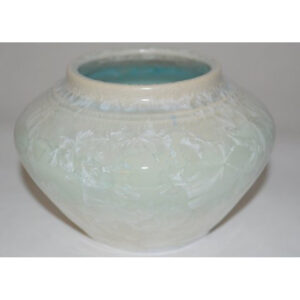Wedding White Crystalline Vessel, Porcelain with Crystalline glaze, watertight. 3 3/4in h x 5 1/2in w
“Crystalline glazes have been used in ceramics for hundreds of years. The process is quite lengthy and costly. Pots are thrown and trimmed at which time colored slips can be applied. Mason stains are used to make the slips as well as using inclusion/pigment stains. Some are rare earth elements. When the foot of the pot is trimmed a measurement is taken. Another piece known as a catcher is thrown to match the foot. After bisque firing the catcher is glued to the pot. This is to catch the flow of the crystalline glaze which will ruin a kiln as well as the shelves. The crystalline glaze itself contains zinc and this is the chemical that will promote the crystals to grow or often said “to blossom”. Zinc seeds can also be used. This technique is called seeding. The crystals begin forming at the top of the pot, continuing to form going down. A base glaze is made and colorants are added to color to the crystals. The glaze is then applied to the pot either by brushing or spraying on. When the pot is dry, it is then fired again. There are numerous programs that can be used for this. The goal is to hit the sweet spot and hold it for a period of time to allow the crystals to grow. Most firings have 6-8 segments to the program. Firing takes three days to complete. When the kiln falls below 100 degrees the pots are taken out. In the firing the pot has now become fused to the catcher. A propane torch is used and with any luck will separate them. If successful the bottom of the pot is then ground and smoothed using a diamond disc to remove any sharp particles.”
CRYSTALLINE AWARDS
2006 Second Prize – Norwich Arts Council – Norwich, Connecticut
2011 First Prize- New Britain Museum of American Art – New Britain, Connecticut
2012 Jurors Award- New Britain Museum of American Art – New Britain, Connecticut

